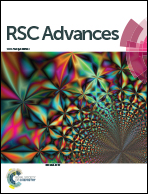Aqueous-phase detection of antibiotics and nitroaromatic explosives by an alkali-resistant Zn-MOF directed by an ionic liquid†
Abstract
An alkali-resistant Zn-MOF directed by [BMI]Br ionic liquid, (BMI)2[Zn3(ptptc)2] (1), based on a π-electron-rich terphenyl-tetracarboxylic acid, has been synthesized under the combination of hydro/solvothermal and ionothermal condition (BMI = 1-butyl-3-methylimidazolium, H4ptptc = p-terphenyl-3,3′′,5,5′′-tetracarboxylic acid). In 1, the trinuclear Zn(II) clusters are linked by the organic moieties of the ptptc ligands, resulting in a 3D anionic framework structure with highly disordered [BMI]+ cations filled in the pores. 1 exhibits good chemical stability in water and NaOH solutions (pH range of 7–12), which allow it to detect antibiotics and nitroaromatic explosives in an aquatic system. 1 represents high fluorescence quenching efficiency toward NFs (furazolidone, FZD; nitrofurazone, NZF; nitrofurantoin, NFT), NMs (ronidazole, RDZ; metronidazole, MDZ; dimetridazole, DTZ; ornidazole, ODZ) and nitrophenol (2-nitrophenol, 2-NP; 3-nitrophenol, 3-NP; 4-nitrophenol, 4-NP; 2,4,6-trinitrophenol, TNP) in water solution, respectively.

- This article is part of the themed collections: Metal-organic frameworks and their applications and Sensors for health and happiness


 Please wait while we load your content...
Please wait while we load your content...